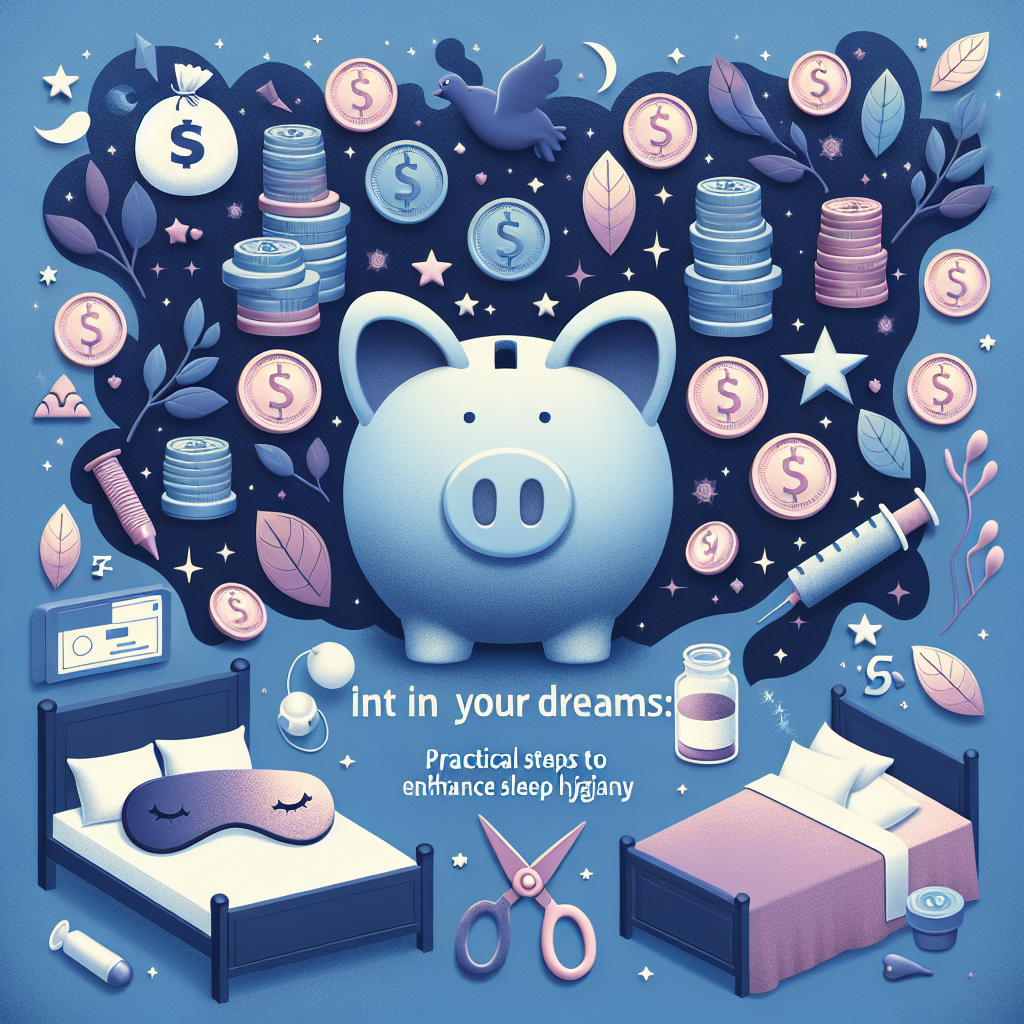
Invest in Your Dreams: Essential Steps to Enhance Sleep Hygiene
Introduction
In our fast-paced world, sleep is often the first sacrifice we make in pursuit of success. However, what if I told you that investing in your sleep could be one of the most transformative decisions of your life? Sleep isn’t just a luxury; it’s a cornerstone of good health, productivity, and well-being. Yet, despite its importance, many individuals struggle with inadequate sleep and poor sleep hygiene. This article presents a comprehensive guide, Invest in Your Dreams: Practical Steps to Enhance Sleep Hygiene, that will empower you to take control of your sleep environment, both physically and mentally.
Understanding Sleep Hygiene
Sleep hygiene refers to a series of practices and habits that are essential for quality sleep. Poor sleep hygiene can lead to insomnia, fatigue, and a myriad of health issues. To invest in your dreams, understanding the fundamentals of sleep hygiene is crucial. By optimizing your sleep environment and pre-sleep routines, you enhance your chances of achieving a restful night’s sleep.
What is Sleep Hygiene?
Sleep hygiene encompasses:
- Sleep Environment: The physical setting where you sleep, including noise, light, and temperature.
- Pre-Sleep Activities: Routines and habits before bedtime that can influence sleep quality, such as screen time and caffeine intake.
- Sleep Schedule: Consistency in sleep and wake times.
Investing in your dreams starts with establishing effective sleep hygiene practices.
The Importance of a Sleep-Conducive Environment
Your environment plays a critical role in sleep quality. Investing in a comfortable mattress, blackout curtains, and white noise machines can significantly enhance the quality of your rest.
Case Study 1: The Bedroom Makeover
Situation: Maria, a 32-year-old teacher, consistently felt fatigued despite spending several hours in bed.
Actions: Maria researched sleep hygiene and decided to revamp her bedroom. She invested in a memory foam mattress, organized her space to eliminate clutter, and purchased blackout curtains.
Results: After just one week, Maria reported feeling more refreshed and alert upon waking. Her productivity improved at work, demonstrating the power of a conducive sleep environment.
Factors to Consider for Your Sleep Environment:
| Factor | Recommended Action |
|---|---|
| Light | Use blackout curtains to eliminate external light. |
| Noise | Consider using a white noise machine if you live in a noisy area. |
| Temperature | Maintain a cool room temperature for optimal comfort. |
| Comfort | Invest in a quality mattress and pillows that support your sleep. |
Establishing a Consistent Sleep Schedule
Investing in your dreams also requires you to establish a consistent sleep schedule. Our bodies thrive on routine. Irregular sleep patterns can disrupt your internal clock and lead to insomnia.
How to Create a Consistent Schedule
- Set a Fixed Bedtime and Wake Time: Choose sleep and wake times that you can stick to, even on weekends.
- Limit Naps: If you choose to nap, do it early in the afternoon for no longer than 20-30 minutes.
- Wind Down: Designate at least 30 minutes to relax before bed without screens.
Case Study 2: John’s Journey to Sleep Consistency
Situation: John, a tech entrepreneur, struggled with sleep due to his unpredictable work schedule.
Actions: He made a commitment to go to bed and wake up at the same time every day, even on weekends.
Results: Over a month, John noticed improved focus at work and better overall mood, illustrating the profound effects of a consistent sleep schedule and the importance of investing in your dreams.
The Role of Pre-Sleep Activities
Your pre-sleep activities can either set the tone for a peaceful night or lead to restlessness. It’s essential to disengage from stimulating activities and create a calming pre-sleep ritual.
Recommended Pre-Sleep Activities
- Reading: Choose light or enjoyable material instead of technology-based reading.
- Meditation: Practicing mindfulness can significantly reduce stress and foster relaxation.
- Gentle Stretching: Incorporate light stretches or yoga to unwind.
Case Study 3: Sarah’s Calming Routine
Situation: Sarah, a 28-year-old nurse, often found herself wired from a long shift with no way to unwind.
Actions: She started a calming routine a half-hour before bed that included gentle stretching and reading a book.
Results: After several weeks, Sarah reported falling asleep faster and enjoying deeper sleep, a true testament to the power of pre-sleep rituals as critical components in the quest to invest in your dreams.
Nutrition and Sleep Hygiene
What you consume plays a significant role in your sleep quality. Investing in your dreams means being mindful of your diet, particularly preceding bedtime.
Foods to Embrace and Avoid
| Food Category | Embrace | Avoid |
|---|---|---|
| Beverages | Herbal tea (chamomile, lavender) | Caffeinated drinks (coffee, soda) |
| Snacks | Almonds, bananas | High-sugar snacks |
| Dinners | Light, early meals | Heavy, greasy meals late at night |
Technology and Sleep Hygiene
In our digital age, technology can be both a hindrance and a help. The blue light emitted from screens can suppress melatonin production, making it harder to fall asleep.
Tips for Managing Technology Use
- Set Screen Limits: Turn off screens at least an hour before bedtime.
- Use Blue Light Filters: Use apps or settings that reduce blue light exposure on devices in the evening.
- Create Tech-Free Zones: Keep electronics out of the bedroom to promote better sleep hygiene.
Creating a Sleep-Friendly Bedroom Design
Your bedroom should be a sanctuary for rest. Here are actionable decorating tips that can help enhance your sleep hygiene:
Steps for Designing a Sleep Sanctuary
- Choose Calming Colors: Opt for cool tones like blues or greens that promote relaxation.
- Decorate Sparingly: Keep decor minimal to reduce visual clutter.
- Invest in Quality Bedding: Soft, breathable fabrics can elevate your comfort level.
Case Study 4: Emily’s Tranquil Retreat
Situation: Emily, a graphic designer, felt her bedroom was too chaotic for sleep.
Actions: She redesigned her space with calming colors, adopted minimalistic decor, and bought a high-quality duvet.
Results: Emily found herself sleeping more soundly and waking up with renewed energy. This case underscores the importance of creating a calming space as a major investment in your dreams.
Overcoming Sleep Disorders
For those suffering from sleep disorders, investing in your dreams may require professional help. Consulting with a healthcare provider or sleep specialist can guide you toward effective treatments.
Common Sleep Disorders
| Disorder | Symptoms | Treatment Options |
|---|---|---|
| Insomnia | Difficulty falling/staying asleep | Cognitive Behavioral Therapy (CBT), medication |
| Sleep Apnea | Interruption in breathing | CPAP machines, lifestyle changes |
| Restless Leg Syndrome | Uncomfortable sensations in legs | Medications, lifestyle modifications |
The Psychological Aspect of Sleep
Mental health has a profound influence on sleep hygiene. Anxiety and depression can lead to sleep disturbances. Investing in your dreams means addressing the psychological factors affecting your rest.
Tips for Managing Mental Wellness for Better Sleep
- Mindfulness and Stress Reduction: Incorporate relaxation techniques such as meditation into your daily routine.
- Cognitive Behavioral Techniques: Recognize and challenge negative thoughts related to sleep.
- Therapy: Consider seeking professional help if anxiety or depression are affecting your sleep hygiene.
Conclusion
Investing in your dreams is essential for overall well-being, productivity, and health. By enhancing your sleep hygiene through optimizing your environment, establishing a consistent schedule, and being mindful of what you consume, you can significantly improve your sleep quality. Implementing the practical steps outlined in this article will empower you to take control of your sleep and, by extension, your life. Remember, every investment in your sleep is an investment in your dreams—a crucial component in achieving your goals and living your best life.
FAQs
1. What are the signs of poor sleep hygiene?
Signs may include difficulty falling asleep, frequent waking during the night, waking up feeling unrefreshed, and daytime fatigue.
2. How long should I aim to sleep each night?
Most adults require between 7-9 hours of sleep per night for optimal health and performance.
3. Can sleep hygiene impact mental health?
Yes, poor sleep hygiene can contribute to anxiety and depression. Prioritizing sleep hygiene can help improve mental health outcomes.
4. Is it okay to use sleep aids?
While some may find over-the-counter or prescription sleep aids helpful, they should be used cautiously and under the guidance of a healthcare professional.
5. How can I establish a calming bedtime routine?
Creating a calming routine may include activities such as reading, meditation, gentle stretching, or taking a warm bath to help signal your body that it’s time to unwind.
In summary, investing in your dreams by enhancing your sleep hygiene is not just an option; it is a necessity. Take these steps today to create a better tomorrow.


















